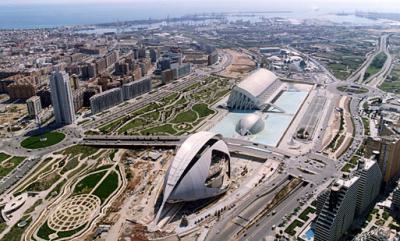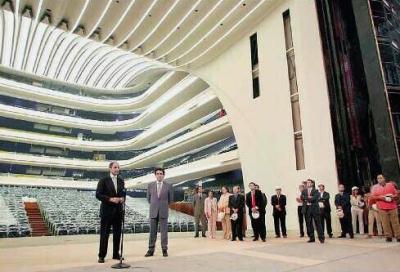EL REY HA MUERTO, VIVA EL REY Sep 24, 09:52
We first came to Valencia in November, 2003 on a charter flight from Geneva with 100 other Cup officials and team reps. The announcement that Valencia had been chosen over the other finalist cities -- Lisbon, Marseille and Naples -- had been made by Pierre-Yves Firmenich, Commodore of the Société Nautique de Genève ("SNG" -- Alinghi's home club) at noon that day.
For much of that flight I sat wth Dennis Conner and Bill Trenkle and mused about the past, present and future of the Cup. At one point, Dennis said, simply, "the Cup is dead, long live the Cup." After being involved with Dennis in one way or another over six Cup campaigns one learns to look beyond what may sound like a shallow comment for deeper meaning.
And, of course, DC was saying that, from the days' events, it was now quite clear that the old Cup era was gone, and a new one had dawned.
The next day from the window of a tour bus we saw for the first time the newly developed area of Valencia called the la Ciudad de las Artes y Ciencias -- the City of the Arts and Sciences. The most striking building was then in the midst of contstruction, and appeared to be a huge fish. Turns out to be a conquistador's helmet housing the new Palace of the Arts.
Since that first day in Valencia we have watched what, at times, has appeared to be painfully slow progress on this most impressive edifice. (For example, the top piece of helmet is attached only at the base on the north end, and is cantalevered -- no other attachment -- over the entire distance to the other end.) In the past few weeks it has finally started to look nearly finished, at least from the outside. Good thing, as it is scheduled to open in two weeks time....
Here, courtesy of this morning's Valencia Life is a bit of a preview:
Yesterday, Francisco Camps, the President of the Valencian Community, visited the new Palau de Les Arts in the City of Arts and Sciences in Valencia, accompanied by the Palau’s designer, Valencian architect Santiago Calatrava.
One of the most impressive elements of the new building is a 530 square metre stage area with a proscenium some 70 metres high. The first concert is slated to take place in the Palau on October 8, as work is frantically continuing on the other theatres in the building. This building, unlike the station that Mr. Calatrava designed for New York, features white concrete and glass along with sensuous lines. All in all the new Palau will have a total of four auditoria, with the main theatre having an orchestra pit capable of taking 120 musicians.
Dennis was right about the Cup. Valencia is in the same boat. The King is dead. Long live the king.

Looking southeast over the long-time coming but nearly finished
Palau de Les Arts (foreground), out to the Port America's Cup
(background, left) and the Med.

Sr Camps (left) and Sr Calatrava inside the impressive main auditorium
yesterday.
For much of that flight I sat wth Dennis Conner and Bill Trenkle and mused about the past, present and future of the Cup. At one point, Dennis said, simply, "the Cup is dead, long live the Cup." After being involved with Dennis in one way or another over six Cup campaigns one learns to look beyond what may sound like a shallow comment for deeper meaning.
And, of course, DC was saying that, from the days' events, it was now quite clear that the old Cup era was gone, and a new one had dawned.
The next day from the window of a tour bus we saw for the first time the newly developed area of Valencia called the la Ciudad de las Artes y Ciencias -- the City of the Arts and Sciences. The most striking building was then in the midst of contstruction, and appeared to be a huge fish. Turns out to be a conquistador's helmet housing the new Palace of the Arts.
Since that first day in Valencia we have watched what, at times, has appeared to be painfully slow progress on this most impressive edifice. (For example, the top piece of helmet is attached only at the base on the north end, and is cantalevered -- no other attachment -- over the entire distance to the other end.) In the past few weeks it has finally started to look nearly finished, at least from the outside. Good thing, as it is scheduled to open in two weeks time....
Here, courtesy of this morning's Valencia Life is a bit of a preview:
Yesterday, Francisco Camps, the President of the Valencian Community, visited the new Palau de Les Arts in the City of Arts and Sciences in Valencia, accompanied by the Palau’s designer, Valencian architect Santiago Calatrava.
One of the most impressive elements of the new building is a 530 square metre stage area with a proscenium some 70 metres high. The first concert is slated to take place in the Palau on October 8, as work is frantically continuing on the other theatres in the building. This building, unlike the station that Mr. Calatrava designed for New York, features white concrete and glass along with sensuous lines. All in all the new Palau will have a total of four auditoria, with the main theatre having an orchestra pit capable of taking 120 musicians.
Dennis was right about the Cup. Valencia is in the same boat. The King is dead. Long live the king.

Looking southeast over the long-time coming but nearly finished
Palau de Les Arts (foreground), out to the Port America's Cup
(background, left) and the Med.

Sr Camps (left) and Sr Calatrava inside the impressive main auditorium
yesterday.
Valencia | by TFE